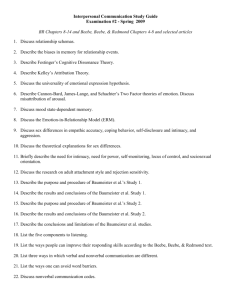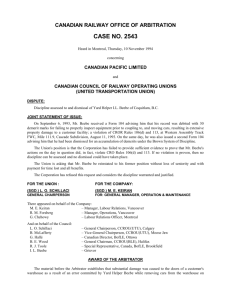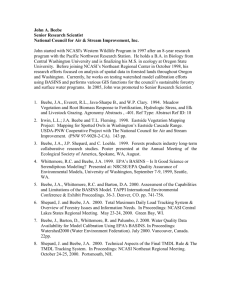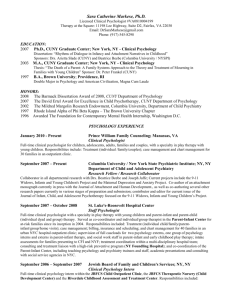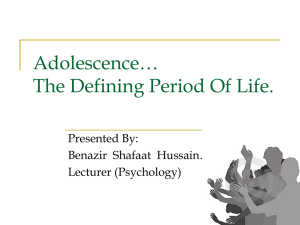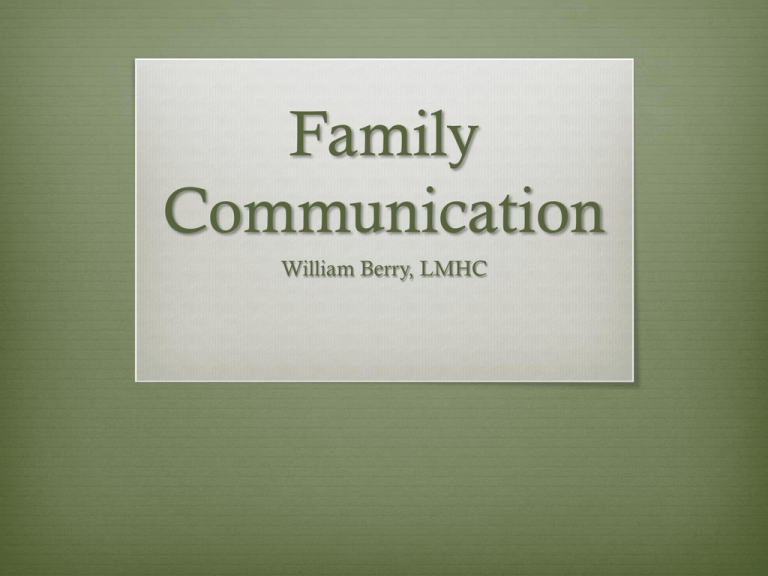
Family
Communication
William Berry, LMHC
Communication is to a
relationship what breathing is to
life
Virginia Satir
Video on couple communication
viewed at this link:
Video
Talking
The average amount of words spoken a day is
16,000. (Mehl, M; Vazire, S; Ramírez-Esparza, N; Slatcher, R;
Pennebaker, J)
But do we actually hear one another?
Carl Rogers, a prominent psychology theorist
and practitioner, stated that “when I take the
gamble, the risk, of sharing something that is
very personal with another individual and it is
not received and not understood, this is a very
deflating and lonely experience.”
80-90% of waking hours include communication. (Beebe,
Beebe, & Redmond; 2011)
This includes passive communication, such as radio or
television.
We spend 60% of our time listening. (Treasure, J., 2011)
We retain only 25% of what we hear. (Treasure, J., 2011)
Communication
90
80
70
60
50
40
30
20
10
0
Communication
Over 86% of couples or families in counseling identify
communication as one of the issues. (Beebe, Beebe, &
Redmond; 2011)
Percentage
Communication
Children
Sex
Money
Leisure
Percentage
Relatives
Infidelity
Housekeeping
Physical Abuse
Other
0
20
40
60
80
100
Family Communication
Families have spoken and, more
predominately, unspoken rules about
communication.
The exercise can illuminate some of your
family’s patterns of communication.
(Redmond;
2008)
Family Communication
According to John Caughlin healthy family
communication consists of:
Openness
Politeness
Maintenance of
Discipline
Expression of
Humor
structural stability
affection
Emotional /
instrumental
support
Mind reading
Regular routine
interaction
Avoidance of hurtful
topics
(Beebe, Beebe, &
Redmond; 2011)
Relational Issues:
Marriage
John Gottman (1994) identified what he
called the Four Horseman of the
Apocalypse, which indicated the health of
a marriage:
Criticism-complaints are okay, they address
behavior. Criticism addresses the person’s
character. An excellent example is “What is wrong
with you?”.
Contempt-According to Gottman contempt is a
sarcastic and cynical approach, eye rolling,
belligerence, and mockery.
Relational Issues:
Marriage (cont.)
The Four Horseman of the Apocalypse,
continued:
Defensiveness-often blames the other, saying it isn’t
me, it’s you.
Stonewalling- the result of escalation of the other
“horsemen” eventually results in one (or both)
“tuning the other out”.
Relational Issues:
Adolescence
Many researchers believe the goal of family
relations is a democratic and intimate
relationship.
However, the differing goals of parents and
adolescent lead to “incompatible aims
which make inconsistency inescapable.”
(Solomon, Y; Warin, J; Lewis, C: and Langford,
W)
Relational Issues:
Adolescence
The majority of disagreements occur because
“teenagers and parents define the issues of
contention differently” (Steinberg, pg. 121).
Parents: right and wrong
Teens: issues of choice
“Adolescents whose parents attempt to regulate
what they believe are personal issues are more
likely to describe their parents as being overly
controlling.” (Steinberg, pg. 122).
Relational Issues:
Adolescence
Despite the common stereotype of
adolescent years being full of tumult:
The stereotype is inaccurate and partly a
result of books focusing on the difficulties
rather than normative development.
Studies indicate the more parents expect
adolescence to be troublesome and that
their teen will be, the worse the relationship
becomes.
Relational Issues:
Adolescence
Adolescents appear to do best when they
grow up in a family atmosphere that
permits the development of individuality
against a backdrop of close family ties.
(Steinberg, pg. 132)
Relational Issues, (cont.)
Reparation
How do you handle disagreements / conflict?
What are your repair attempts?
Do you take breaks to deescalate?
Do you joke, or apologize, or simply say I love
you?
Listening
“Conscious Listening creates understanding.”
(Treasure, J., 2011)
Julian Treasure identifies four ways to improve
interpersonal listening:
R-receive- pay attention to the speaker.
A-appreciate- allow your speaker to realize you are
listening and appreciate what he / she is saying through
making noises.
S-summarize- rephrase, “what I hear you saying is…”
A-ask- ask questions afterward.
Conflict
In a healthy, normal, romantic relationship,
conflict occurs approximately 2x a week.
The longer you know someone, the more
likely conflict is to arise.
(Beebe, Beebe, Redmond; 2011)
Communicating in anger is often
counterproductive.
10
physical
9
8
physical
behavioral
cognitive
cognitive
7
6
5
4
physical
3
2
1-3 Irritated, Frustrated
4-7 Anger
8-10 Rage
behavioral
behavioral
cognitive
1
Conflict Styles
The exercise can help you determine your
most common conflict management styles.
Since the focus of this
seminar is family,
• Instead of “Same
Sex Friend”, use
“Sibling” or one of
your children. (If
neither apply, use a
friend).
• Instead of “Opposite
Sex Friend” use
another child or
sibling.
• If you prefer use
“Partner” instead of
“Parent”.
(Redmond; 2008)
Conflict Styles
David Johnson uses animals to describe
how people deal with conflict. (Goud,
2009)
Although multiple methods are generally
used, people sometimes over rely on one,
and use it at inappropriate times.
Conflict Styles
The Turtle- withdrawals from conflict / Avoidant.
The Teddy Bear- Soothes the conflict /
Accommodation.
The Shark- Wants his goals realized no matter
what. Competition
The Fox- Compromises, gives a little, gets a little.
The Owl- problem solves. Finds a way for all to
get what they want. Collaboration.
Conflict Style
12
10
8
Relationship 6
4
2
0
0
2
4
Goals
6
8
10
12
Conflict Styles
Passive Aggressive
Passive
Manipulative
Assertive
Aggressive
Conflict Resolution
Use I statements
Make sure you make eye contact
Listen, demonstrate interest, don’t just
think of defense.
The power of taking personal responsibility,
saying I’m sorry or I love you.
Useful to express underlying feeling
Conflict Resolution
Slow everything down.
Mindfulness
Be watchful of voice tone and level.
What is the other individuals real message?
Rather than reacting out of conditioned
responses, be mindful of who you want to be
in the situation
Summary
Healthy communication brings benefits to
relationships and to one’s sense of wellbeing.
Conflict is a normal part of life, and there
are ways to deal with it effectively.
Communication patterns within families
are usually well worn, and it is easy to slip
into patterns which have been detrimental.
Summary
Mindfulness, bringing and keeping the
desired change into consciousness as much
as possible, is the beginning of change.
Be aware of the change you want to make,
and focus on bringing that change into
interactions.
Summary
Change is difficult, and it is expected one
will slip into old patterns.
But don’t allow that to lead to giving up.
Any positive change is beneficial.
References
Beebe, S.A; Beebe, S.J; Redmond, M; 2011;
Interpersonal Communication: Relating to Others,
Sixth Ed.
Goud, N; 2009; Psychology and Personal Growth.
Gottman, J; 1994; Why Marriages Succeed or Fail.
Headley, J; 2013; It’s not about the nail. Funny or die.
Retrieved from:
http://www.funnyordie.com/videos/70ca308603/it-snot-about-the-nail
References
Mehl, M; Vazire, S; Ramírez-Esparza, N; Slatcher, R;
Pennebaker, J; Are Women Really More Talkative
Than Men?; Retrieved from
http://homepage.psy.utexas.edu/homepage/faculty/p
ennebaker/reprints/MehletalScience2007.pdf
Redmond, M; 2008; Skillbuilder Workbook for Beebe
Beebe and Redmond Interpersonal Communication:
Relating to Others
Rogers, Carl. 1969. Freedom to learn
References
Solomon, Y; Warin, J; Lewis, C: and Langford, W;
Intimate talk between parents and their teenage
children: democratic openness or covert control;
Sociology, 2002, 36:4 965–983
Steinberg, L; 2011; Adolescence, Ninth Ed.
Treasure, J; 2011; 5 ways to listen better; TED Talks.
Retrieved from:
http://www.ted.com/talks/julian_treasure_5_ways_to
_listen_better.html

